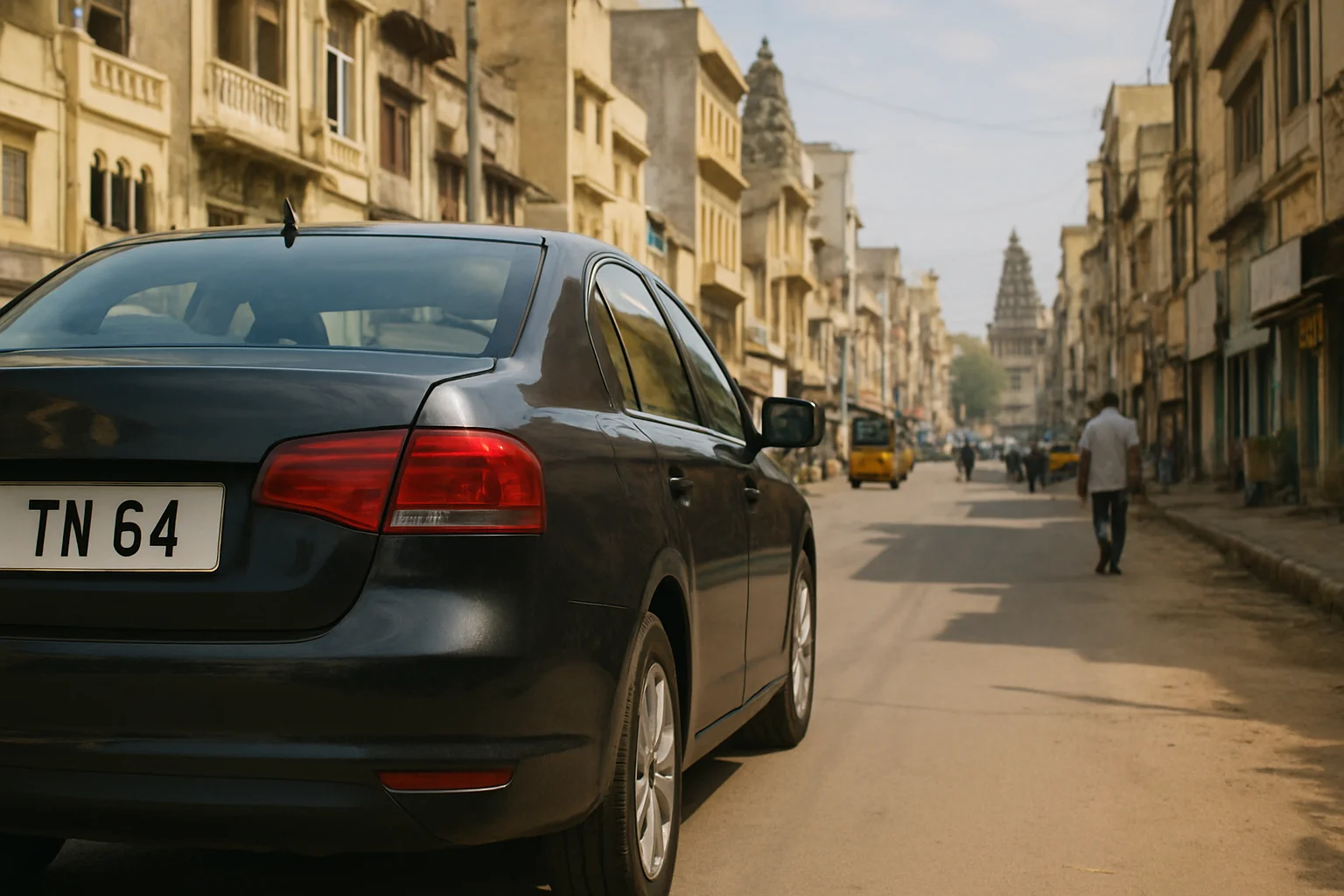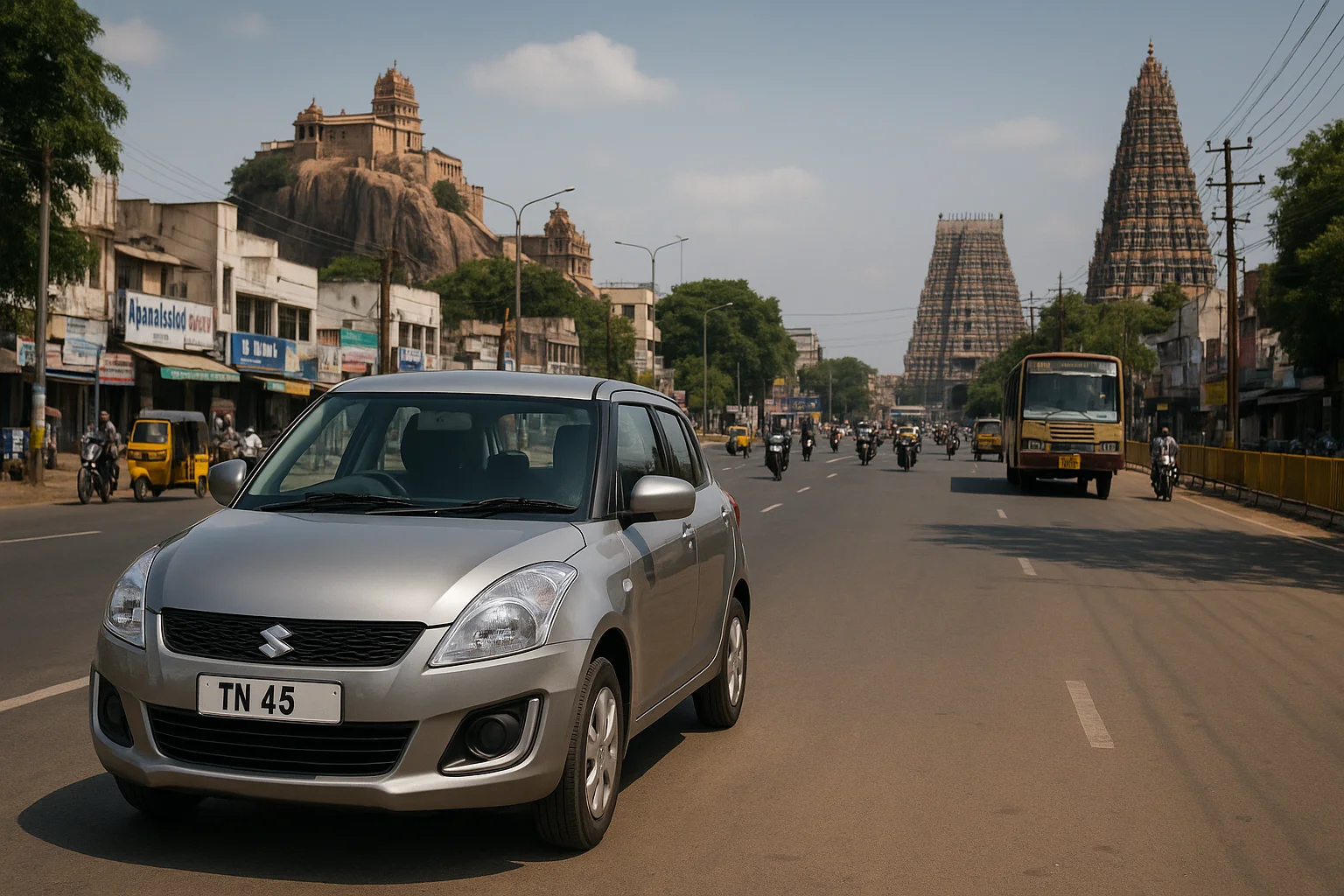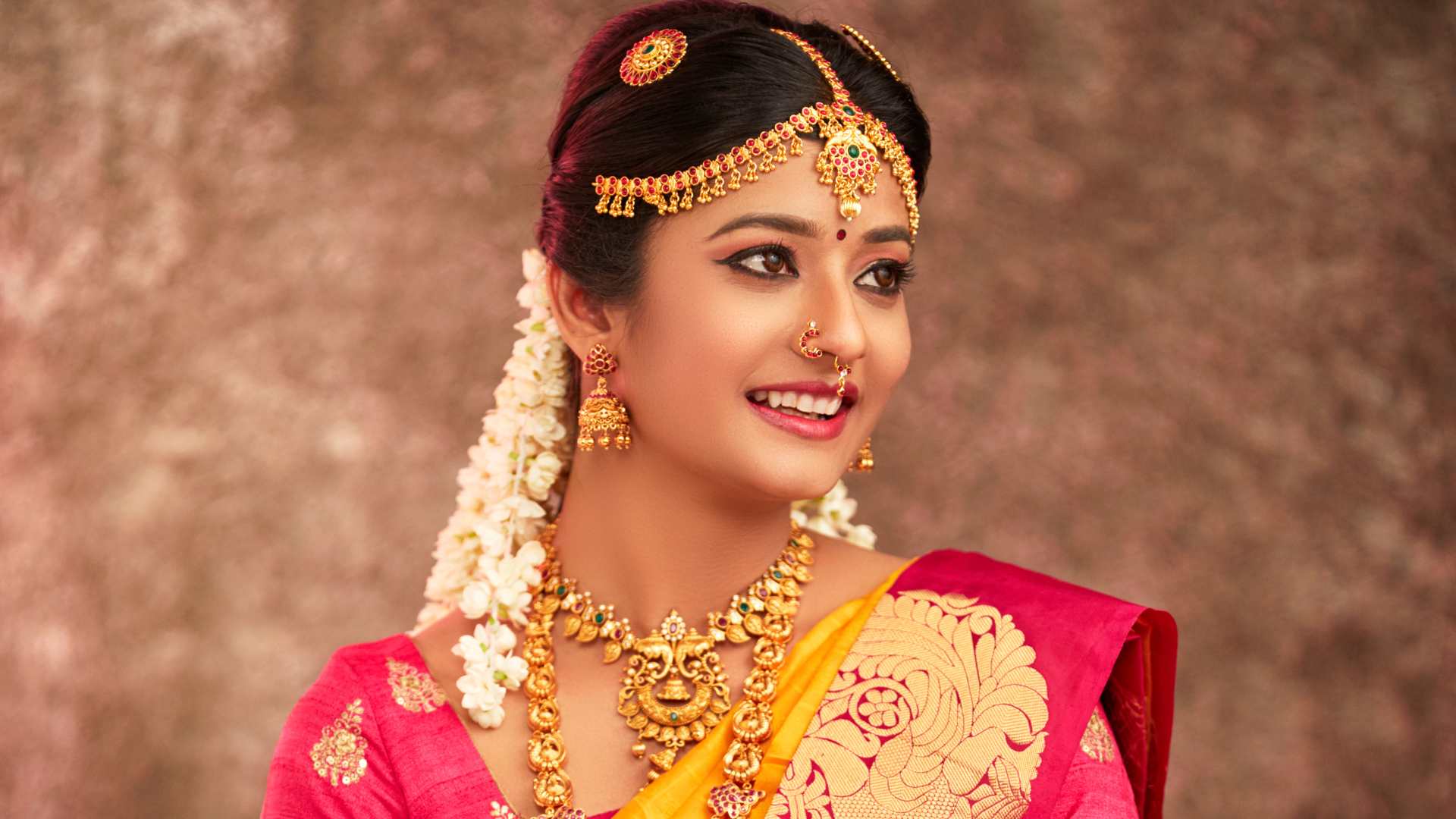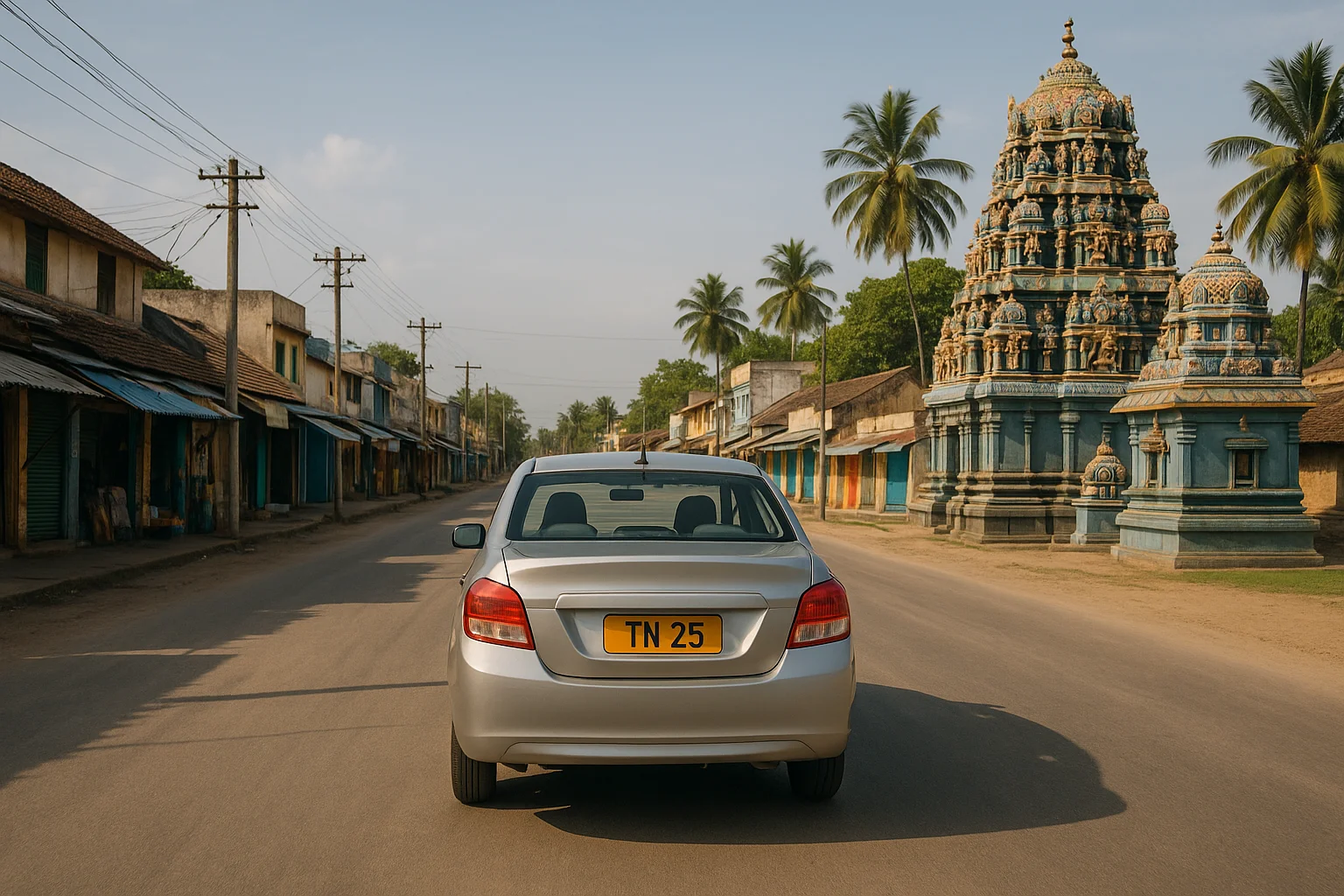Table of Contents
ToggleWhat makes Tamil Nadu’s traditional attire so captivating and unique? Steeped in centuries-old customs, the clothing of Tamil Nadu reflects a deep cultural heritage that is celebrated through intricate designs, bold colours, and remarkable craftsmanship.
Each piece, from the elegant Kanchipuram saree to the iconic veshti, tells a story of Tamil Nadu’s diverse history and rich artistic legacy. These garments are not just clothing but symbols of pride, often worn during festivals, weddings, and rituals that emphasize Tamil values of respect and devotion.
In this guide, we explore the top 10 Tamilnadu traditional wear for male and female, each highlighting the region’s cultural essence and artisanal skill. Discover how these garments preserve Tamil Nadu’s identity and bring its timeless traditions to life.
What Makes Tamil Nadu’s Traditional Waer Unique?
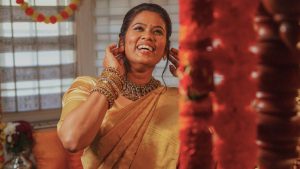
Tamil Nadu’s traditional clothing is distinct for its blend of rich fabrics, vibrant colours, and meaningful motifs inspired by the region’s culture and heritage. Styles like the Kanchipuram saree are renowned for their luxurious silk and zari work, symbolizing Tamil Nadu’s fine craftsmanship.
Traditional attire like the veshti and angavastram for men reflects simplicity and devotion, while the pattu pavadai for young girls captures cultural beauty.
Each garment tells a story of Tamil Nadu’s artistry, with weavers and artisans following techniques passed down through generations. Colours, patterns, and fabrics are chosen with symbolic intent, often representing prosperity, purity, and celebration.
Whether worn during festivals, weddings, or rituals, Tamil Nadu’s traditional attire serves as a meaningful expression of identity, connecting people to their roots through timeless styles.
Why Are Tamil Nadu’s Traditional Wear Worn During Festivals and Ceremonies?
Traditional wear in Tamil Nadu is deeply tied to the region’s spiritual and cultural practices, making these garments especially popular during festivals and ceremonies. These events, such as Pongal, Diwali, and Navaratri, call for clothing that honours Tamil Nadu’s customs, values, and reverence for tradition.
Attires like the Madisar, worn by married women, hold specific religious significance, while the Kanchipuram saree is a wedding staple, symbolizing grace and prosperity. For men, the veshti and angavastram embody respect and simplicity and are suitable for temple visits and rituals.
Wearing these attires during significant occasions pays homage to Tamil heritage and family values, emphasizing the importance of modesty, spirituality, and cultural continuity in Tamil Nadu’s society.
Traditional wear also fosters a sense of unity and identity, helping each generation connect with shared cultural practices. By preserving these attire and customs, Tamil Nadu celebrates and passes down its heritage.
How Does Tamil Nadu’s Weaving Tradition Influence Its Traditional Wear?
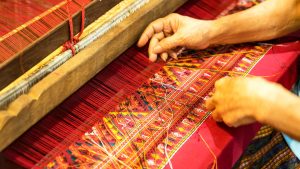
Tamil Nadu’s rich weaving heritage is central to the region’s traditional attire, with craftsmanship that showcases the artistry of its weavers.
Kanchipuram, Madurai, and Coimbatore are well-known textile hubs in Tamil Nadu, each contributing unique styles to traditional wear. Kanchipuram sarees, for instance, are crafted with luxurious silk and gold zari by skilled artisans using age-old techniques.
Tamil Nadu’s weavers often draw inspiration from temple architecture, mythology, and nature, incorporating motifs like flowers, peacocks, and ancient symbols into their designs.
This craftsmanship is what gives Tamil Nadu’s traditional attire its distinctive patterns, vibrant colours, and intricate details, all of which have stood the test of time. Each garment is a testament to Tamil Nadu’s legacy of weaving and its pride in preserving these traditional techniques.
Today, these weavers continue to evolve their skills, blending modern preferences with time-honoured artistry, thus keeping Tamil Nadu’s textile identity alive. This weaving tradition connects generations, making each piece a symbol of both artistry and heritage.
What Are the Symbolic Meanings Behind Colours in Tamil Nadu’s Traditional Wear?
Colors hold significant cultural meanings in Tamil Nadu’s traditional wear, often chosen with great care to reflect values, beliefs, and emotions. Vibrant shades such as red, yellow, green, and blue are commonly seen in Tamil attire and are associated with prosperity, energy, and joy.
For instance, red is frequently chosen for bridal sarees, symbolizing auspiciousness and love, while white veshtis for men represent purity and simplicity. Additionally, gold is commonly used in the zari borders of sarees like the Kanchipuram, reflecting wealth and spirituality.
These colours are not just aesthetic choices; they carry cultural importance, helping to communicate values and emotions at weddings, religious ceremonies, and festivals, reinforcing Tamil Nadu’s respect for tradition and spiritual connection.
The choice of colour extends beyond fashion it’s a way for wearers to express their identity, cultural pride, and respect for traditional values. Colours in Tamil Nadu’s attire thus serve as both a visual and emotional bridge between past and present.
How Has Tamil Nadu’s Traditional Attire Evolved Over Time?
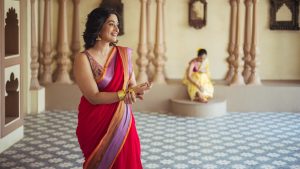
While Tamil Nadu’s traditional attire is rooted in history, it has also evolved to adapt to contemporary preferences and lifestyles. Original styles like the Madisar saree and veshti are still cherished, yet modern versions have introduced lighter fabrics, simplified patterns, and even new draping techniques.
Younger generations have embraced these adaptations, allowing them to honour Tamil Nadu’s cultural heritage while enjoying comfort and style. For example, modern Kanchipuram sarees are often available in lighter silk blends, and kurtas paired with veshti have become popular choices.
These adaptations retain the essence of traditional Tamil attire while making it more accessible and versatile for today’s wearers, demonstrating Tamil Nadu’s ability to honour tradition while embracing change.
Through these adaptations, Tamil Nadu’s attire maintains relevance while respecting its origins, showcasing a harmonious blend of heritage and modernity. This evolution reflects the adaptability and enduring spirit of Tamil Nadu’s fashion.
What Role Does Tamil Nadu’s Traditional Wear Play in Preserving Cultural Heritage?
Tamil Nadu’s traditional attire serves as a living representation of the region’s cultural heritage, connecting generations through shared customs and values. Garments like the Kanchipuram saree, veshti, and pattu pavadai are not only attire but also cultural symbols that reinforce Tamil identity.
These outfits are often worn during important family and cultural events, emphasising respect, unity, and tradition. Tamil Nadu’s textile art, intricate motifs, and unique draping styles contribute to a sense of belonging and pride.
By continuing to wear these traditional garments, Tamilians celebrate their heritage and pass down values to future generations, preserving a cultural legacy that defines Tamil Nadu’s identity and respect for its rich traditions.
In doing so, they ensure that Tamil Nadu’s unique heritage is kept vibrant and relevant. This commitment to traditional attire strengthens cultural continuity, linking Tamil Nadu’s past, present, and future.
Top 10 Tamilnadu Traditional Wear
1. Saree (Sari) – The Quintessential Tamil Nadu Attire

Image – Source
In Tamil Nadu, the saree is more than just a garment; it is a cultural emblem that signifies womanhood, tradition, and artistic heritage. With each saree woven, artisans incorporate not only skill but also generations of textile knowledge, which is why these sarees hold such high sentimental and cultural value.
Among them, the Kanjeevaram saree is particularly revered as it is often handed down through families as a mark of legacy and pride. Traditionally, these sarees play a central role in family and social gatherings, where wearing a Kanjeevaram is seen as a gesture of respect and reverence for Tamil customs.
Sarees in Tamil Nadu are versatile, not only marking formal occasions like weddings but also serving as attire for temple visits and festivals, where their colours and designs create a festive atmosphere.
They reflect a timeless connection between the wearer and Tamil Nadu’s rich past, often sparking nostalgia while adapting seamlessly to modern-day wear. The saree’s significance goes beyond beauty it is a living part of Tamil identity, cherished across generations as a symbol of continuity, respect, and grace.
Saree Details
| Feature | Description |
| Traditional Outfits | The Kanjeevaram saree represents Tamil Nadu’s pride, often worn during weddings and festivals. |
| Regional Craftsmanship | Kanjeevaram sarees are known for intricate, handwoven designs by skilled Tamil weavers. |
| Materials Used | Pure silk and gold or silver zari threads create this luxurious and durable attire. |
| Motif Inspirations | Temple-inspired designs, mythological figures, and floral motifs make each saree unique. |
| Colour Significance | Vibrant colours like maroon, gold, and green are common, symbolizing joy and prosperity. |
| Draping Styles | Madisar drape style is significant for married women during cultural rituals. |
| Occasional Use | Essential for weddings, festivals, and ceremonies; a cultural staple in Tamil Nadu. |
| Jewellery Pairings | Paired with traditional gold jewellery, including bangles and necklaces with temple motifs. |
| Religious Symbolism | Often worn during rituals, representing spiritual and cultural reverence. |
| Contemporary Adaptations | Lightweight Kanjeevaram sarees are popular, blending traditional design with modern convenience. |
| Distinctive Borders | Bold, contrasting borders add uniqueness, highlighting Tamil Nadu’s weaving techniques. |
| Geographical Influence | Kanchipuram’s silk sarees dominate, with unique varieties across Tamil Nadu. |
| Environmental Considerations | Silk sarees are preferred for cooler events; lighter cotton sarees are for daily use in hot weather. |
| Iconic Festivals | Key attire for festivals like Pongal and Diwali enhances the celebratory mood. |
2. Veshti (Dhoti) – Traditional Male Attire
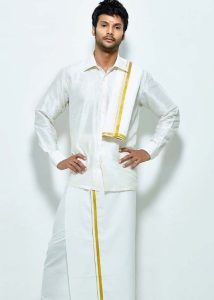
Image – Source
In Tamil Nadu, the veshti is more than a garment; it embodies a sense of heritage, continuity, and cultural pride for Tamil men. Rooted in simplicity, this traditional attire is deeply respected as a symbol of Tamil identity and is often worn to honour family, tradition, and community.
The veshti is typically passed down through generations, with each wearer embracing the garment’s longstanding association with purity and dignity. Whether worn during festivals, family gatherings, or temple visits, the veshti connects Tamil men to their roots, carrying forward values of humility and respect.
The veshti’s appeal lies in its versatility, making it suitable for both everyday wear and ceremonial occasions. Its unstitched design, draped in a way that allows ease and comfort, has endured as a practical yet profound expression of Tamil culture.
This timeless garment has a distinct way of bridging the past and present, embodying a continuity of customs that Tamil men proudly uphold. Worn with reverence, the veshti remains a cherished and meaningful attire that reflects the values and identity of Tamil Nadu’s people.
Veshti Details
| Feature | Description |
| Traditional Outfits | Worn by men, the veshti symbolizes cultural pride and simplicity. |
| Regional Craftsmanship | Tamil weavers create veshtis with intricate borders in contrasting colours. |
| Materials Used | Primarily made from cotton, silk versions with zari borders are for special occasions. |
| Motif Inspirations | Minimalistic design with a focus on borders inspired by Tamil tradition. |
| Colour Significance | Primarily white or cream, symbolizing purity; colourful borders signify festivity. |
| Draping Styles | Wrapped at the waist, variations exist for formal events with angavastram. |
| Occasional Use | Essential for weddings, religious rituals, and festivals. |
| Jewellery Pairings | Simple gold jewellery, like rudraksha beads, may be worn alongside veshti. |
| Religious Symbolism | Common attire for temple visits, signifying spiritual respect. |
| Contemporary Adaptations | Some men pair veshtis with modern shirts or blazers for a blended style. |
| Distinctive Borders | Borders are often in contrasting colours, a distinctive style in Tamil Nadu attire. |
| Geographical Influence | Dhoti variations exist across India, but Veshti has a unique Tamil Nadu touch. |
| Environmental Considerations | Cotton veshtis are ideal for the hot climate of Tamil Nadu, ensuring comfort. |
| Iconic Festivals | Commonly worn during Pongal, weddings, and other Tamil cultural festivals. |
3. Pavadai (Pattu Pavadai) – Traditional Dress for Young Girls
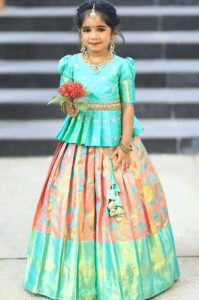
Image – Source
The pavadai, or pattu pavadai, is a cherished symbol of youth, tradition, and familial pride in Tamil Nadu. Designed especially for young girls, this attire is a joyful expression of Tamil Nadu’s heritage, often associated with the innocence and vibrancy of childhood.
Passed down as a valued part of family tradition, the pavadai is often chosen for significant life moments, from attending family gatherings to participating in temple rituals. This attire brings a sense of pride, connecting each new generation to the elegance and beauty of Tamil culture.
Beyond its beauty, the pavadai has a functional charm, offering both comfort and freedom of movement for young wearers. Its simple yet sophisticated design allows young girls to partake in festivities with ease, making it ideal for celebratory occasions.
Recently, adaptations in fabric and styling have made the pavadai more accessible for everyday use, yet the garment continues to honor the heritage it represents. Embracing tradition with a touch of modernity, the pattu pavadai remains a timeless part of Tamil Nadu’s cultural identity and an emblem of cherished memories for countless families.
Pavadai Details
| Feature | Description |
| Traditional Outfits | A silk pavadai is commonly worn by young girls for cultural and religious events. |
| Regional Craftsmanship | Skilled artisans design pattu pavadais with detailed borders and colourful patterns. |
| Materials Used | Silk is the primary material, often featuring zari borders for elegance. |
| Motif Inspirations | Temple motifs, floral designs, and traditional symbols are popular in pavadais. |
| Colour Significance | Bright colours like red, yellow, and green are chosen for their vibrant appearance. |
| Draping Styles | The pavadai is a two-piece outfit, allowing young children to wear it easily. |
| Occasional Use | Ideal for festivals, family gatherings, and weddings. |
| Jewellery Pairings | Girls often wear gold or imitation jewellery to match their pattu pavadai. |
| Religious Symbolism | Often worn to temples, representing respect for Tamil Nadu’s customs. |
| Contemporary Adaptations | Lightweight fabrics and modern patterns are now seen in pattu pavadais. |
| Distinctive Borders | The skirt often features a wide, contrasting border in rich hues. |
| Geographical Influence | Popular across South India, but Tamil Nadu has its distinct pavadai style. |
| Environmental Considerations | Silk is best for cooler temperatures, though lighter fabrics are available for everyday wear. |
| Iconic Festivals | Worn during Pongal, Diwali, and other important festivals, symbolizing festivity and joy. |
4. Salwar Kameez – Comfortable and Traditional Women’s Wear
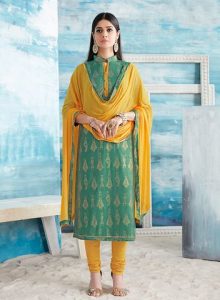
Image – Source
The salwar kameez is a popular and versatile outfit among Tamil women, and it is appreciated for its comfort and adaptability.
Originally from North India, it has become a staple in Tamil Nadu, often customized with regional prints, patterns, and lighter fabrics to suit the local climate.
Women wear it in various forms, from casual daily wear to more elaborate versions for special occasions. This attire combines a long tunic (kameez) with loose-fitting pants (salwar), allowing ease of movement and elegance.
In Tamil Nadu, salwar kameez designs often incorporate bold, vibrant colours and motifs inspired by traditional art and nature. Younger women especially favour this outfit due to its simplicity and adaptability for both formal and informal settings.
The salwar kameez highlights Tamil Nadu’s openness to evolving fashion trends while maintaining a connection to traditional roots, showcasing a blend of culture and modern style.
Salwar Kameez Details
| Feature | Description |
| Traditional Outfits | A popular outfit for women, blending traditional and modern styles. |
| Regional Craftsmanship | Tamil Nadu adds its touch with local prints and embroidery. |
| Materials Used | Cotton, silk, and lightweight fabrics for breathability in warm climates. |
| Motif Inspirations | Traditional art forms, floral designs, and geometric patterns are popular. |
| Colour Significance | Bright, cheerful colours are often chosen, symbolizing energy and festivity. |
| Draping Styles | Worn as a two-piece outfit with a scarf or dupatta for elegance. |
| Occasional Use | Versatile for both daily wear and festive events, often tailored for each occasion. |
| Jewellery Pairings | Often paired with earrings, bangles, and simple necklaces, adding cultural charm. |
| Religious Symbolism | Chosen based on comfort and modesty, suitable for religious gatherings. |
| Contemporary Adaptations | Modern salwar kameez includes lighter fabrics and trendy designs. |
| Distinctive Borders | Borders may have contrasting or intricate designs to highlight the outfit. |
| Geographical Influence | Widely worn across South India, adapted uniquely in Tamil Nadu. |
| Environmental Considerations | Cotton versions are ideal for hot weather, offering comfort and breathability. |
| Iconic Festivals | Worn during family gatherings and festivals, showcasing Tamil Nadu’s evolving style. |
5. Half Saree (Langa Voni) – Adolescent Girls’ Attire

Image – Source
The half saree, or langa voni, is a significant garment for young Tamil women transitioning from childhood to adulthood. This attire features a skirt (langa), a blouse, and a draped cloth (voni) over the shoulder.
Known for its vibrant colours and rich silk fabric, the half saree is symbolic and often worn during cultural ceremonies, festivals, and family events. It is a cherished dress among adolescent girls, representing modesty and tradition.
The half saree’s beauty lies in its elaborate designs, with each piece often decorated with intricate borders and motifs that are reflective of Tamil Nadu’s artistry.
With options in various colours and fabrics, the half saree offers a traditional yet playful look, combining elegance and cultural pride. It remains a popular choice among young women, particularly for formal gatherings, maintaining its relevance in Tamil Nadu’s rich cultural landscape.
Half Saree Details
| Feature | Description |
| Traditional Outfits | Worn by adolescent girls, symbolizing cultural and familial transition. |
| Regional Craftsmanship | Tamil weavers add intricate borders and patterns to half sarees. |
| Materials Used | Silk and cotton, with zari borders, enhance the elegance. |
| Motif Inspirations | Designs inspired by temples, nature, and floral patterns. |
| Colour Significance | Bright colours symbolize youth, festivity, and energy. |
| Draping Styles | Draped across the shoulder, with the voni gracefully hanging over the skirt. |
| Occasional Use | Ideal for cultural events, festivals, and family functions. |
| Jewellery Pairings | Paired with earrings, necklaces, and bangles to enhance traditional charm. |
| Religious Symbolism | Often chosen for rites of passage, reflecting modesty and cultural pride. |
| Contemporary Adaptations | Modern versions include simplified drapes and lightweight materials. |
| Distinctive Borders | Elaborate borders add depth and contrast, a hallmark of Tamil half sarees. |
| Geographical Influence | Unique to South India, with regional influences from Tamil Nadu’s textile craft. |
| Environmental Considerations | Lightweight versions are popular in Tamil Nadu’s warm climate. |
| Iconic Festivals | Worn during Pongal, Navaratri, and other festive occasions, honouring Tamil heritage. |
6. Angavastram – A Traditional Shawl for Men
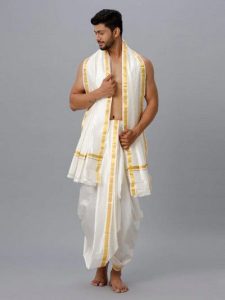
Image – Source
The angavastram is more than just a garment; it is a symbol of respect, tradition, and Tamil identity. Worn by Tamil men during important life events and cultural ceremonies, the angavastram embodies the values of simplicity and dignity that Tamil culture holds dear.
Its presence enhances not only the wearer’s attire but also the significance of the occasion, marking a man’s connection to his roots and his reverence for customs passed down through generations. Families often treasure angavastrams, preserving them as sentimental heirlooms that carry stories and memories from one generation to the next.
With its versatile design, the angavastram adapts seamlessly to both formal and everyday settings, adding elegance to traditional attire while honouring the wearer’s heritage. Worn over the shoulder or around the neck, it complements various outfits and serves as a reminder of the deep-rooted pride in Tamil Nadu’s customs.
Despite evolving trends, the angavastram remains integral to Tamil Nadu’s cultural dress, respected by men of all ages who value tradition as a cornerstone of their identity.
Angavastram Details
| Feature | Description |
| Traditional Outfits | A shawl-like cloth for men, enhancing the veshti during cultural events. |
| Regional Craftsmanship | Tamil Nadu craftsmen add zari borders, giving a unique touch to angavastrams. |
| Materials Used | Cotton for daily wear, silk with zari for special occasions. |
| Motif Inspirations | Simple yet elegant designs, focusing on contrast and simplicity. |
| Colour Significance | Usually white or off-white, representing purity and simplicity. |
| Draping Styles | Draped over one shoulder or around the neck. |
| Occasional Use | Popular during religious rituals, weddings, and formal gatherings. |
| Jewellery Pairings | Often worn without additional accessories, maintaining a clean, dignified look. |
| Religious Symbolism | Worn during temple visits and religious ceremonies as a sign of respect. |
| Contemporary Adaptations | Paired with modern shirts or veshti for a blended look. |
| Distinctive Borders | It often features zari or coloured borders, adding a distinctive flair. |
| Geographical Influence | Found across South India, with unique regional styles in Tamil Nadu. |
| Environmental Considerations | Cotton versions are preferred for comfort in hot weather. |
| Iconic Festivals | Worn during Pongal, Tamil New Year, and other cultural celebrations. |
7. Kanchipuram Silk Saree – A Symbol of Tamil Nadu’s Craftsmanship
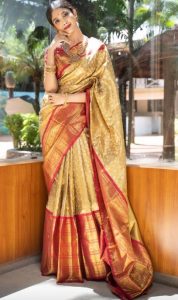
Image – Source
The Kanchipuram silk saree is an iconic traditional Tamil Nadu garment celebrated for its luxurious silk fabric and intricate designs. Handwoven by skilled artisans, these sarees feature elaborate borders with motifs inspired by temples, flora, and Tamil mythology.
The durability and richness of the Kanchipuram silk saree make it a preferred choice for weddings and significant cultural events, reflecting Tamil Nadu’s heritage and craftsmanship.
Available in vibrant colours like red, blue, and green, the Kanchipuram saree showcases bold and contrasting borders, a hallmark of Tamil weaving. The saree represents Tamil Nadu’s pride and is cherished as an heirloom passed down through generations, making it both a cultural and fashion statement.
Each saree tells a story of tradition, skill, and artistic excellence. With newer designs blending tradition and modernity, the Kanchipuram saree remains beloved by younger generations. It embodies both elegance and a profound respect for Tamil Nadu’s artisanal legacy.
Kanchipuram Silk Saree Details
| Feature | Description |
| Traditional Outfits | Worn by women during weddings and festivals, symbolizing elegance and pride. |
| Regional Craftsmanship | Handwoven by skilled Tamil Nadu artisans, showcasing intricate borders and motifs. |
| Materials Used | Luxurious silk and zari threads for added richness and durability. |
| Motif Inspirations | Temple art, mythological figures, and floral designs adorn each saree. |
| Colour Significance | Vibrant colours like red, blue, and gold symbolise festivity and prosperity. |
| Draping Styles | Draped in traditional styles like the Madisar for added significance. |
| Occasional Use | A staple for weddings, religious rituals, and formal gatherings. |
| Jewellery Pairings | Gold jewellery enhances the saree’s beauty, including bangles, necklaces, and earrings. |
| Religious Symbolism | Worn during auspicious events, symbolizing respect for tradition and spirituality. |
| Contemporary Adaptations | Modern versions include lightweight fabrics with simplified motifs. |
| Distinctive Borders | Known for its bold, contrasting borders, a Tamil Nadu speciality. |
| Geographical Influence | Exclusive to Kanchipuram in Tamil Nadu, with a reputation for quality and elegance. |
| Environmental Considerations | Preferred for cooler climates and essential occasions due to its heavy silk fabric. |
| Iconic Festivals | Popular attire during Pongal, Diwali, and Tamil New Year, showcasing Tamil craftsmanship. |
8. Kurta-Pajama – Simple yet Traditional Men’s Wear

Image – Source
Kurta-pajama is a classic choice for Tamil men, offering both comfort and style. The kurta, a long tunic, is paired with loose-fitting pajamas, creating an outfit that blends simplicity with tradition.
This attire is popular across Tamil Nadu, often worn for cultural events, family gatherings, and informal celebrations. The design varies, with embroidery or minimal detailing for festive occasions, while plain options are preferred for daily wear.
In Tamil Nadu, kurta-pajama has evolved with modern adaptations, including lighter fabrics and contemporary patterns that appeal to younger generations.
Many men wear it alongside a veshti for a layered traditional look, especially during weddings or festivals. This outfit exemplifies Tamil Nadu’s mix of cultural pride and modernity, highlighting its adaptability in a rapidly changing fashion landscape.
Kurta-Pajama Details
| Feature | Description |
| Traditional Outfits | It is worn by Tamil men for its simplicity and elegance and is suitable for various occasions. |
| Regional Craftsmanship | Often enhanced with subtle embroidery or patterns, emphasizing local craftsmanship. |
| Materials Used | Cotton and silk are common, with variations in linen for breathability and comfort. |
| Motif Inspirations | Traditional motifs are kept subtle, focusing on simplicity and understated elegance. |
| Colour Significance | Earthy tones and whites are popular, with brighter colours chosen for festivities. |
| Draping Styles | Usually worn as a two-piece without draping, paired with veshti for layered formality. |
| Occasional Use | Suitable for family gatherings, religious functions, and casual celebrations. |
| Jewellery Pairings | Sometimes paired with a simple chain or bracelet, maintaining a minimalistic look. |
| Religious Symbolism | Often worn for its modesty and comfort, fitting well with Tamil Nadu’s cultural values. |
| Contemporary Adaptations | Modern kurtas feature slim fits and patterns, catering to younger preferences. |
| Distinctive Borders | Kurtas may feature contrasting collar trims or hems, adding subtle detailing. |
| Geographical Influence | Popular across India, with Tamil Nadu adding distinct patterns and colours. |
| Environmental Considerations | Cotton kurtas are preferred in Tamil Nadu’s warm climate, providing comfort and ease. |
| Iconic Festivals | Worn during Tamil New Year, Diwali, and family functions, celebrating simplicity and tradition. |
9. Madisar – Traditional Draping Style for Married Women
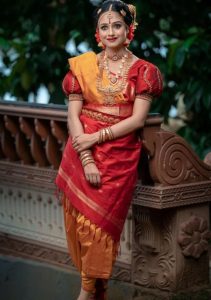
Image – Source
The Madisar is a unique draping style of the saree, traditionally worn by Tamil Brahmin women. Unlike regular saree styles, the Madisar is draped in a way that creates a double wrap, symbolizing the wearer’s marital status and religious devotion.
This traditional attire is essential for Tamil weddings and other significant religious occasions, especially among older generations who honour its cultural value.
Wearing the Madisar is a skill passed down through generations, with each drape and fold adding to its symbolic meaning.
The nine-yard saree is intricately wrapped, often in auspicious colours like red or yellow, and is paired with traditional jewellery, making it a quintessential element of Tamil heritage.
Despite modern saree styles, the Madisar is a respected garment in Tamil Nadu’s cultural landscape. Its unique draping style is a source of pride, reflecting Tamil Nadu’s devotion to preserving tradition. To this day, the Madisar remains a strong cultural emblem, revered for its timeless elegance and ceremonial importance.
Madisar Details
| Feature | Description |
| Traditional Outfits | A distinctive nine-yard saree style symbolizing marriage and spirituality in Tamil Brahmin culture. |
| Regional Craftsmanship | Known for precise draping techniques, requiring skill and cultural knowledge. |
| Materials Used | Silk and cotton, with zari, are often incorporated for special occasions. |
| Motif Inspirations | Traditional motifs are minimalistic, focusing more on draping style than pattern. |
| Colour Significance | Red and yellow are popular colours, symbolizing auspiciousness and marital devotion. |
| Draping Styles | Draped uniquely with a double-wrap style, distinct to Tamil Nadu’s Brahmin community. |
| Occasional Use | Worn mainly during weddings, religious ceremonies, and cultural events. |
| Jewellery Pairings | Worn with traditional gold jewellery, such as necklaces, bangles, and nose rings. |
| Religious Symbolism | It represents religious reverence and respect and is often worn during prayers and rituals. |
| Contemporary Adaptations | Less common in daily wear, but modern women sometimes opt for simplified Madisar versions for festivals. |
| Distinctive Borders | Sarees may have contrasting zari borders, enhancing the garment’s sacred look. |
| Geographical Influence | Specific to Tamil Nadu, with significant cultural symbolism among Tamil Brahmins. |
| Environmental Considerations | Silk Madisars are best suited for formal events; cotton is more common for comfort. |
| Iconic Festivals | Frequently worn during Brahmin weddings, Navaratri, and Tamil New Year celebrations. |
10. Dhavani – Traditional Wrap for Young Girls

Image – Source
The Dhavani, or half-saree, is a beloved traditional outfit that holds a unique place in Tamil culture, marking a young girl’s journey toward adulthood with elegance and simplicity.
Often considered a significant milestone, wearing the Dhavani for the first time is a celebrated moment in Tamil families, symbolizing the transition from childhood to womanhood.
This outfit is cherished for its embodiment of cultural values, modesty, and respect, making it an ideal choice for religious gatherings and family ceremonies.
Though traditionally worn by younger girls, the Dhavani’s timeless appeal has also led to its adaptation in contemporary fashion, where it’s appreciated for its blend of style and heritage. Young women now wear it in updated styles, merging traditional designs with modern elements while retaining its symbolic essence.
In this way, the Dhavani remains a cherished garment, connecting generations with a shared appreciation for Tamil heritage and youthful grace.
Dhavani Details
| Feature | Description |
| Traditional Outfits | A traditional three-piece outfit for young girls, representing their transition to adulthood. |
| Regional Craftsmanship | Often embellished with borders and designs that showcase Tamil weaving techniques. |
| Materials Used | Silk, cotton, and lighter fabrics are commonly used to add comfort and elegance. |
| Motif Inspirations | It often incorporates floral patterns, temple motifs, and geometric designs. |
| Colour Significance | Bright colours like pink, green, and red are popular, symbolizing youthfulness and celebration. |
| Draping Styles | Features a draped dupatta over the shoulder, creating an elegant look. |
| Occasional Use | Worn during festivals, temple visits, and family celebrations, it is ideal for cultural events. |
| Jewellery Pairings | Often matched with bangles, earrings, and necklaces, adding traditional charm. |
| Religious Symbolism | Worn as a mark of modesty and respect, often during religious festivals. |
| Contemporary Adaptations | Modern dharani include simpler designs that are easy to understand and cater to younger preferences. |
| Distinctive Borders | Richly decorated borders are common, reflecting Tamil Nadu’s focus on detailing. |
| Geographical Influence | Dhavani is unique to South India, with a distinct style in Tamil Nadu. |
| Environmental Considerations | Cotton dhavani are popular in warmer weather, while silk versions are worn for formal events. |
| Iconic Festivals | Worn during Pongal, Navaratri, and traditional ceremonies, celebrating Tamil customs. |
Conclusion
Tamil Nadu’s traditional wear offers a window into a culture that is as vibrant as it is enduring. From the intricately woven Kanchipuram sarees to the dignified veshti, these garments reflect the spirit of Tamil Nadu, capturing its traditions, beliefs, and history.
Each outfit in this list of top 10 traditional dresses brings out a unique facet of Tamil Nadu’s heritage, embodying values of grace, modesty, and pride.
In a world of evolving fashion trends, Tamil Nadu’s traditional wear continues to stand the test of time, blending cultural reverence with timeless style.
Embracing these attires preserves Tamil Nadu’s heritage and celebrates the artistry and devotion of its people, who cherish and honour their customs through these beloved garments.
FAQs About Tamilnadu Traditional Wear
What are some popular traditional dresses in Tamil Nadu?
Kanchipuram sarees, veshti, pattu pavadai, and Madisar are among the popular traditional attire in Tamil Nadu.
Why is the Kanchipuram saree significant in Tamil Nadu?
The Kanchipuram saree, crafted with luxurious silk and intricate designs, symbolizes Tamil Nadu’s heritage and is highly valued at weddings.
What traditional dress do Tamil men wear?
Tamil men commonly wear the veshti paired with an angavastram, especially during religious and cultural ceremonies.
What does the colour red signify in Tamil Nadu’s traditional attire?
Red symbolizes auspiciousness, love, and prosperity, making it popular in Tamil Nadu’s bridal and festive wear.
How are Tamil Nadu’s sarees different from others in India?
Tamil Nadu’s sarees, especially Kanchipuram, are known for their rich silk, zari borders, and unique temple-inspired motifs.
What role does traditional attire play during Tamil Nadu’s festivals?
Traditional attire, like sarees and veshtis, is worn during festivals as a mark of cultural respect and celebration.
How has Tamil Nadu’s traditional wear adapted to modern times?
Lighter fabrics and simplified designs have made Tamil Nadu’s traditional attire more versatile and comfortable for contemporary use.

